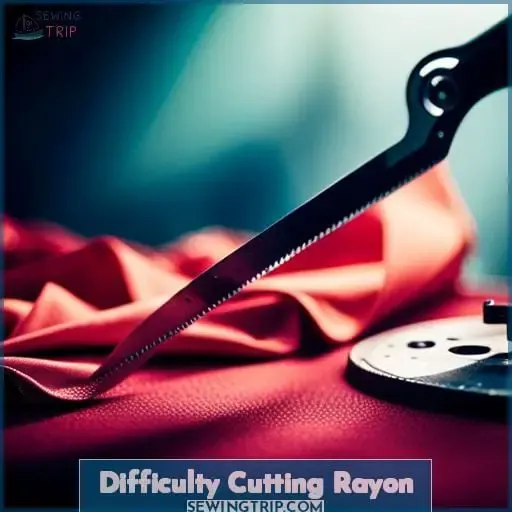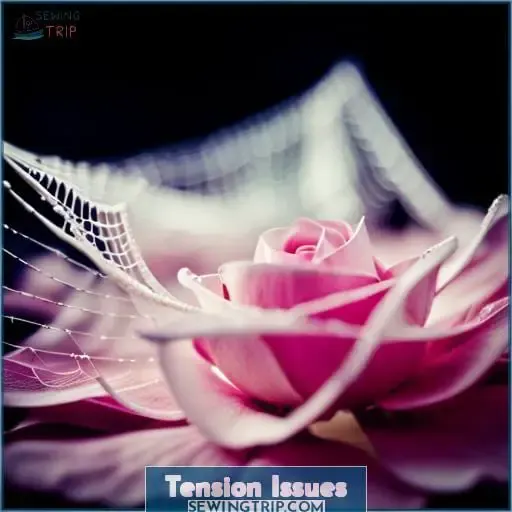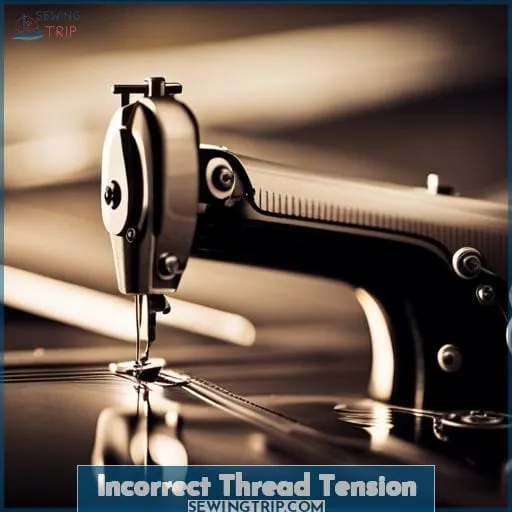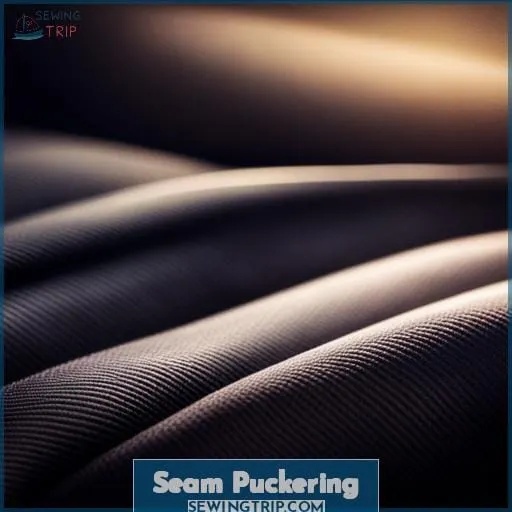This site is supported by our readers. We may earn a commission, at no cost to you, if you purchase through links.
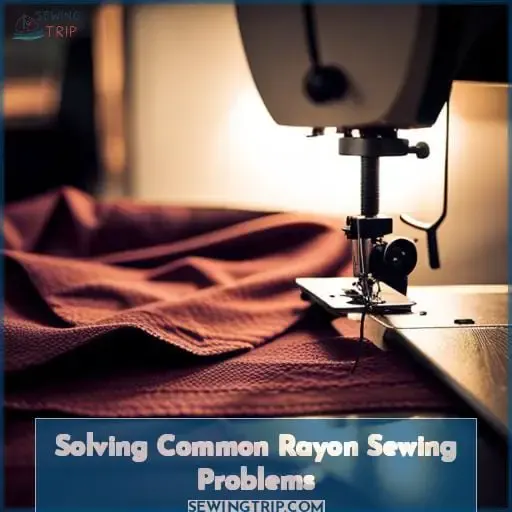 Imagine effortlessly gliding your needle through the smooth, luxurious fabric of rayon.
Imagine effortlessly gliding your needle through the smooth, luxurious fabric of rayon.
In this article, we’ll reveal the secrets to solving common rayon sewing problems and empower you with the skills to create stunning garments that will turn heads. Whether it’s difficulty cutting, slippery fabric, or tension issues, we’ve got you covered.
Say goodbye to wrinkled seams and hello to a world where rayon is no longer a challenge but an opportunity for creativity and mastery.
Table Of Contents
Key Takeaways
- Use a sharp blade and cutting mat for clean cuts on rayon viscose fabric.
- Employ stabilizers or tissue paper to prevent slipping and stretching of the fabric.
- Pre-wash or steam rayon fabric to manage wrinkles and creases.
- Ensure proper machine maintenance and alignment for optimal stitching results.
Difficulty Cutting Rayon
Cutting rayon can be challenging due to its slippery texture and tendency to fray easily.
First, make sure you have a sharp blade when cutting rayon fabric. A dull blade will only lead to frayed edges and frustration. Additionally, using a cutting mat underneath the fabric will provide stability and prevent slipping during the cutting process.
When it comes to sewing foot options, choose one with a wide flat edge that can effectively grip the slippery surface of rayon. This will help guide your fabric through the machine without any unwanted sliding or shifting.
To further stabilize your cut pieces of rayon before sewing them together, consider using stabilizers or tissue paper under the fabric while stitching on bias edges or intricate designs.
Finally, pressing for precision is crucial when working with rayon as it tends to shrink easily under heat. Use a low heat setting on your iron and always press gently on top of a pressing cloth for added protection against potential damage.
By incorporating these techniques into your workflow when working with difficult-to-cut fabrics like Rayon,you’ll achieve cleaner cuts,resulting in more professional-looking finished garments
Slippery Fabric
When sewing with rayon, preventing the fabric from sliding can be achieved by using a presser foot with a wide, flat edge.
Slippery fabrics like rayon challis require extra attention to ensure stitch stability and precise fabric handling.
To enhance control and prevent shifting during stitching, consider using sewing aids such as stabilizers or tissue paper underneath the fabric. These aids provide additional support and reduce stretching that’s common with slippery materials.
In addition to utilizing appropriate tools, adjusting stitch length can also contribute to better results when working with slippery fabrics like rayon challis. Experimenting with different stitch lengths will help you find the optimal setting for your specific project while maintaining proper tension throughout the process.
Remember that needles play an essential role in achieving successful stitches on slipperier fabrics too! Choosing a fine needle size suited for lightweight materials ensures smooth penetration without damaging delicate fibers.
By combining these techniques – utilizing a presser foot designed for slip prevention, incorporating sewing aids like stabilizers or tissue paper underneath the material surface during stitching processes – along adjusting both stitch length/stitch density accordingly , you’ll have more control over your work when dealing specifically about ‘Slippery Fabric’ issues encountered while working on projects involving Rayon.
Stretching Fabric
To prevent stretching, use a lighter touch on the sewing machine and opt for a shorter stitch length.
Rayon is known for its stretchy nature, which can cause problems when sewing. By using a lighter touch on the machine and choosing a shorter stitch length, you can help prevent the fabric from stretching excessively while being sewn.
Additionally, selecting the right thread tension is crucial in preventing stretching of rayon fabric. Adjusting your thread tension to suit this type of fabric will ensure that it stays taut during stitching without causing any unnecessary strain or distortion.
Another important aspect to consider when working with rayon is proper fabric support. Using backing choices such as stabilizers or tissue paper underneath the fabric can provide additional stability during sewing and minimize potential stretchiness.
It’s also worth noting that pre-washing your rayon before starting your project can help reduce further shrinkage or stretching once it’s been sewn into garments or other items.
By following these tips – adjusting stitch length and thread tension appropriately, providing proper backing choices for support ,and pre-washing – you’ll be able to successfully prevent excessive stretching when working with delicate fabrics like rayon.
Wrinkles and Creases
If you’re working with rayon fabric, you may encounter the frustrating issue of wrinkles and creases. Rayon is known for its tendency to wrinkle easily due to its fiber characteristics. However, there are pressing techniques that can help minimize these unsightly wrinkles and creases.
Before sewing with rayon, it’s important to properly prepare the fabric by pre-washing or steaming it. This helps relax any fibers that may cause excessive wrinkling during sewing. Additionally, using a stay stitch along the edges of your fabric can provide extra stability and prevent stretching.
When pressing rayon, always remember to use heat protection such as a pressing cloth or an iron set on low temperature. Too much heat can damage this delicate fabric. Gently press your garment without dragging the iron across the surface.
To further prevent wrinkles while sewing with rayon, consider using starch spray on your fabric before cutting out pattern pieces or stay stitching them together. Starch adds stiffness which makes handling easier and reduces potential wrinkling.
Lastly, having proper tools like a good quality steam iron or garment steamer will greatly assist in eliminating any remaining wrinkles during final finishing touches on your sewn garments made from this beautiful but finicky material.
Tension Issues
Check your thread tension to avoid common rayon sewing problems.
Tension issues can wreak havoc on your stitching balance, leading to a frustrating and unsatisfying sewing experience.
To troubleshoot tension problems, start by checking the needle adjustments and machine calibration.
Ensure that the needle is inserted properly into the needle bar and that the bobbin is correctly placed in its case.
Next, make sure that your machine is threaded correctly according to manufacturer’s instructions.
When it comes to working with rayon viscose or embroidery threads, using a light weight thread can help alleviate tension issues.
Additionally, consider adjusting the tension dial on your sewing machine if necessary – turning it clockwise for tighter tensions or counterclockwise for looser tensions.
Incorporating proper embroidery backings can also aid in achieving balanced stitches when working with delicate fabrics like rayon viscose.
Experimenting with different types of backings such as tear-away or cut-away options may be beneficial depending on your specific project needs.
By paying attention to these key tips for troubleshooting thread tension issues and mastering proper stitch balance techniques when working with rayon fabric or embroidery threads, you’ll gain greater control over your projects while creating beautifully stitched garments every time.
Incorrect Thread Tension
Now that you have learned about tension issues and how they can affect your sewing, let’s delve into the specific problem of incorrect thread tension. This issue can cause a range of problems with stitch quality, such as seam puckering, fabric stretching, skipping stitches, and random loops.
To troubleshoot this issue effectively and achieve optimal results in your rayon sewing projects, it’s important to follow these steps:
- Sew a test seam on a scrap piece of fabric to check if your thread tension is correct. The seam should appear smooth and flat on both sides while the needle and bobbin threads interlock midway between the material surfaces.
- If your thread tension is too loose resulting in loops on the underside of the seam, tighten it by turning the tension dial clockwise.
- Conversely if you notice loops forming on top side indicating tight thread tensions adjust them by turning counterclockwise.
- Remember that besides incorrect machine settings other factors like needle choices,bobbin adjustments,and proper handling play crucial roles in achieving balanced tensions.
By understanding how to troubleshoot incorrect thread tensions,you will be able to create impeccable stitches for all your rayon garments,enabling you feel empowered as you master this versatile fabric option.
Needle or Bobbin Not Inserted Properly
When inserting the needle or bobbin, it’s important to ensure they’re properly inserted to avoid sewing problems.
Improper insertion can lead to issues with thread tension and stitching accuracy.
To avoid these problems, make sure that the needle is aligned correctly in the needle bar and that the bobbin is placed correctly in the bobbin case.
Check if the needle is centered in the hole of the needle plate and if there are any loops forming on either side of your seam which indicates incorrect threading.
Proper threading also plays a crucial role in preventing sewing issues when working with rayon fabric.
Make sure you follow your machine’s manufacturer instructions for correct threading techniques for optimal results.
By ensuring proper alignment and placement of both needles and bobbins, as well as following proper threading techniques, you’ll be able to achieve accurate stitching while working with rayon fabric.
Remember regular machine maintenance such as cleaning out lint build-up from around needles/bobbins/threads areas helps prevent future mishaps during operation leading towards better embroidery outcomes ultimately making life easier!
Machine Not Threaded Correctly
To ensure smooth sewing with rayon fabric, make sure you have threaded your machine correctly.
Threading troubles can lead to a whole host of problems such as bobbin woes and stitching snags. One common issue that arises from improper threading is incorrect thread tension.
When the machine isn’t threaded correctly, it can throw off the balance between the needle and bobbin threads, resulting in uneven stitches or even skipped stitches.
Thread tension plays a crucial role in achieving professional-looking seams on rayon fabric. If the tension is too loose, you may experience seam puckering or fabric stretching. On the other hand, if it’s too tight, random loops may appear on your stitching.
Thankfully there are sewing solutions for these threading troubles! First and foremost, always refer to your sewing machine manufacturer’s instructions when threading your machine – this will save you time and frustration down the line.
Additionally:
- Make sure both needle thread and bobbin thread are properly inserted.
- Check that they interlock midway between surfaces of material during test seam.
- Adjust tension dial clockwise for looser tensions; counterclockwise for tighter tensions.
By following these simple steps and paying attention to detail when threading your machine correctly , you’ll be able to conquer any obstacles related to improper thread tension while working with delicate rayon fabrics
Seam Puckering
If you’re experiencing seam puckering while sewing with rayon, there are a few possible causes and solutions to consider.
Here are some tips to help you solve the issue of seam puckering:
- Adjust your stitch length:
- Experiment with different stitch lengths to find the one that works best for rayon fabric.
- A shorter stitch length can reduce the chances of puckering as it provides more stability.
- Rayon is known for its tendency to stretch and shift during sewing.
- To prevent this, make sure you handle the fabric gently and avoid excessive pulling or pushing while guiding it through the machine.
- Check if your needle has been inserted correctly into your sewing machine.
- The flat side should face towards the back or left side, depending on your machine’s instructions.
- Incorrect thread tension can contribute to seam puckering issues in rayon fabrics.
- If you notice tight stitches causing puckerings, try loosening up your upper thread tension slightly.
- On the other hand, if loose stitches are causing problems, tighten up your upper thread tension just a bit until they become more secure.
By following these tips and making adjustments where necessary, you’ll be able to minimize or even eliminate seam puckering when working with rayon fabrics.
Fabric Stretching
If you’re experiencing fabric stretching while sewing with rayon, make sure to avoid excessive pulling and pushing on the fabric.
Rayon is a stretchy fabric that requires some special considerations to prevent unwanted stretching.
When working with rayon, it’s important to choose the right thread for your project.
Opt for a high-quality thread that has good strength and elasticity to help prevent any potential stretching issues.
In addition to thread selection, consider using embroidery techniques that can minimize stretching.
For example, using fill stitches or multiple lines of walking stitches can help distribute tension evenly across the fabric surface.
When designing your projects, take into account design considerations that can reduce the likelihood of fabric stretching during sewing.
Avoid designs with long continuous lines or large uninterrupted areas as they’re more prone to distortion and stretch.
Finally, when selecting backing choices for embroidery on rayon fabrics, opt for backings that provide adequate support without adding too much bulk or stiffness.
Experimenting with different backing materials and weights will allow you to find what works best for your specific project.
By following these tips on preventing stretching in rayon fabrics through proper thread selection, embroidery techniques consideration in design choices ,and thoughtful backing choices,you’ll be able achieve beautiful results without worrying about unwanted distortions caused by excess strain on the material
Frequently Asked Questions (FAQs)
How do I prevent my rayon fabric from fraying?
Prevent rayon fabric from fraying by using:
- A sharp blade and cutting mat to ensure clean cuts.
- Applying fray check.
- Sewing around the edges with a zigzag stitch for added reinforcement.
What type of thread should I use when sewing rayon?
When sewing rayon, opt for a lightweight thread that complements the delicate nature of the fabric.
Choose with confidence and conquer your rayon projects effortlessly!
How can I prevent my rayon fabric from wrinkling after sewing?
Prevent wrinkling in your rayon fabric by:
- Pressing it before sewing.
- Using a pressing cloth to protect from heat damage.
- Using the right thread tension.
- Using a light touch on the machine.
- Using a shorter stitch length.
What is the best way to stabilize rayon fabric before sewing?
To stabilize rayon fabric before sewing, use a stabilizer or tissue paper underneath.
This will prevent the fabric from stretching and sliding while you sew, ensuring smooth and precise stitches.
Take control of your sewing with this simple technique!
How can I fix tension issues when sewing with rayon?
To conquer tension issues when sewing with rayon, embrace the power of a light touch.
Adjust your machine’s tension, choose a lightweight thread, and let your stitches flow effortlessly.
Master the art of balanced tension for flawless creations.
Conclusion
Transform your rayon sewing experience from frustrating to fabulous with these simple solutions to common problems.
[Keypoints]Say goodbye to:
- Difficulty cutting
- Slippery fabric
- Tension issues
Learn how to properly:
- Thread your machine
- Insert your needle and bobbin
Overcome challenges like:
- Seam puckering
- Fabric stretching
To create stunning garments with ease.
With these tips and tricks, you’ll be able to confidently work with rayon and unleash your creativity.
Don’t let rayon be a challenge, embrace it as an opportunity for mastery.

